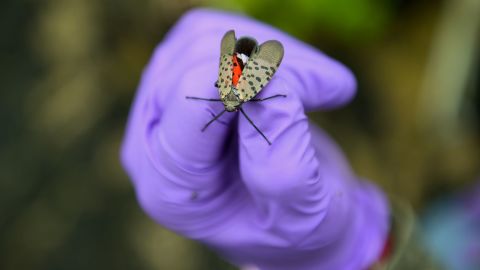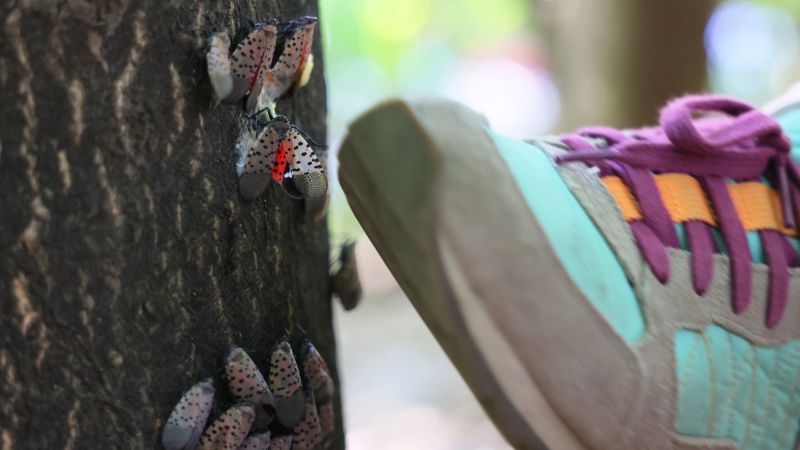Editor’s Note: Danae Wolfe is a conservation educator, writer, and nature photographer. She manages Chasing Bugs, a platform that promotes appreciation and stewardship of insects and spiders. The opinions in this commentary are her own. Read more opinion at CNN.
CNN
—
If you live in the eastern United States and have been besieged by infestations of spotted lanternflies, your misery is almost over: With the weather getting cooler, adult lanternflies will gradually die off and disappear entirely before winter. But relief is likely to be temporary, as a new brood of the highly invasive insects is set to emerge in the spring.
If you’ve been lucky enough so far not to have seen swarms of lanternflies in your neighborhood, it may only be a matter of time. Female lanternflies are already laying their eggs, which will overwinter on trees and on hard surfaces. Given that each egg mass contains 30-50 eggs, we could be looking at large armies of the insects again beginning in May.

There will probably be thousands fewer lanternflies than there might have been, given that untold numbers have been hunted and stomped to death in recent months. But to be perfectly honest, all of the squashing barely put a dent in the lanternfly population. To slow its inexorable spread across the United States, we will need a more strategic approach.
Research published in June predicted that, without more aggressive preventative management, the spotted lanternfly has a high probability of reaching California within the next decade, which could prove devastating to the state’s wine industry. Some Pennsylvania vineyards have already seen 90% of their harvest destroyed in recent years. Wine producers in Virginia and New York are bracing for similar devastation.
Native to Asia, the spotted lanternfly (Lycorma delicatula) was first found in the United States in 2014 in a stand of tree of heaven (Ailanthus altissima) in Berks County, Pennsylvania. Experts believe the insect made its way here after hitchhiking on a shipment of stone from China a few years earlier. Since then, populations of the pest have spread to well over a dozen eastern states.
After overwintering, spotted lanternfly eggs hatch in the spring, giving way to small nymphs that are black with white spots. As they grow, the nymphs turn red while retaining black and white spots, eventually maturing into colorful, winged adults. To some, the insect resembles a moth, but spotted lanternfly is a true bug – with piercing, sucking mouthparts that help it feed on plants, which can cause wilting and dieback of host plants and a decline in crop yield and quality. To make matters worse, spotted lanternflies secrete a sugary substance called honeydew as they feed, which aids in the growth of black sooty mold and may attract additional pests which can further damage trees.
But killing lanternflies one by one, while emotionally satisfying for some, might not be enough to rid us of the pests. More effective containment methods are being explored in the interlude before their re-emergence in the spring.
One eradication method involves limiting the spotted lanternfly’s access to its favorite vegetation. The insect has been observed feeding on over 100 plant species worldwide, but its meal of choice is the tree of heaven, an aggressive, invasive tree that hails from lanternflies’ native regions in Asia and is helping the insects spread by providing them a ubiquitous food source.
The tree of heaven was brought to the United States in the 1700s as a fast-growing exotic shade tree. Known for its ability to thrive in even the harshest environments, it inspired Betty Smith’s classic 1943 novel, A Tree Grows in Brooklyn, as a symbol of endurance. And endure, it has: The qualities that made the tree desirable centuries ago have made it nearly impossible to eradicate today.
Researchers are studying the effectiveness of controlling tree of heaven populations through fungal pathogens, which may help limit the insect’s westward spread. Targeting tree of heaven with insecticides may also help reduce lanternfly populations. When done correctly, this “trap tree” method can be effective at killing adult lanternflies before they lay their eggs.
Since little else feeds on tree of heaven, the risk to non-target organisms is minimal. Experts warn, however, that insecticides must be applied at the right time of year to be most effective.
Other research involves the use of parasitoid wasps which can attack spotted lanternflies in their egg or nymph stages, before the pest reproduce. But since these parasitoids are not native to the US either, more research is needed to ascertain if they could also become problematic.
Mother Nature is also lending a hand in a small way at keeping the numbers of this pest in check: Indiscriminate predators like praying mantises, birds, bats, frogs, and snakes have been observed feeding on the lanternfly, providing some hope that nature will one day be able to provide its own checks and balances.

Unfortunately, it takes time to restore balance after the introduction of a new species. Predator-prey relationships are usually a product of evolution, developing over many hundreds or thousands of years making it difficult for nature to quickly adapt. Predators simply haven’t developed a taste yet, for the lanternfly.
So, are the campaigns to squash the bug helping at all? In a word, yes. Every little bit helps: Adult and nymph lanternflies should be swiftly killed when spotted. But exercise care before coming down hard with the boot – naturalists are finding that people have inadvertently been killing a variety of other insects having mistaken them for lanternflies, including moths and other beneficial bugs. Take time to learn how to properly identify the pest.
A more effective measure than killing individual adults is keeping an eye out for and disposing of lanternfly eggs. During the fall months, adult females lay gray egg masses. These masses resemble splotches of mud or plaster on hard flat surfaces like trees, though spotted lanternflies will lay eggs on other surfaces like buildings, playground equipment, and cars.
If found, spotted lanternfly egg masses should be scraped from surfaces into a plastic bag and filled with rubbing alcohol or hand sanitizer. When traveling, especially to an area with a known infestation, be sure to check family members and pets, vehicles, and camping and other outdoor gear before leaving.
Wrapping trees with sticky bands to capture nymphs as they emerge can also be an effective control measure, but some experts oppose this idea noting that sticky bands indiscriminately capture and injure all sorts of other wildlife including birds, bats, and beneficial insects.
While individual action won’t completely eradicate the spotted lanternfly, it can help curb its spread, giving researchers – and nature – time to catch up. And individual action might grow into collective action, eliciting a legislative response or corporate initiatives: Both will be needed to better monitor international trade and commerce and provide better checks on imported and exported goods, which could help identify and suppress future infestations.
It seems likely that our collective future will include some number of spotted lanternflies in it. But with these efforts at control and management, it might be possible to curb the bug’s worst impacts.







More News
Losing a Foot Never Held Her Back, Until She Tried to Join the Military
‘Challengers’: Normcore Clothes on Sweaty Bodies
‘Challengers’ Review: Game, Set, Love Matches